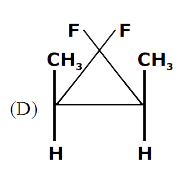CHF2BrOH−−−→(A) [Intermediate] Trans -2-butene−−−−−−−−→(B)




The correct Answer is:C
To solve the question regarding the reaction of CHF₂Br with OH⁻ and then with trans-2-butene, we will break down the process step by step.
Step 1: Reaction of CHF₂Br with OH⁻
The first step involves the reaction of CHF₂Br with a hydroxide ion (OH⁻). The hydroxide ion acts as a base and abstracts a proton (H⁺) from the CHF₂Br molecule.
Chemical Equation:
CHF2Br+OH−→CF2Br−+H2O
Step 2: Formation of Carbene
After the proton abstraction, we have CF₂Br⁻. The bromine (Br) atom is a good leaving group and will leave, resulting in the formation of a carbene intermediate, specifically a singlet carbene (CF₂).
Chemical Equation:
CF2Br−→CF2+Br−
Step 3: Reaction with Trans-2-butene
Now, the singlet carbene (CF₂) will react with trans-2-butene. The double bond in trans-2-butene can react with the carbene. The carbene will insert itself into the double bond of trans-2-butene.
Chemical Structure of Trans-2-butene:
CH3CH=CHCH3
Step 4: Insertion of the Carbene
When the carbene (CF₂) inserts into the double bond of trans-2-butene, it will form a new carbon-carbon bond. The stereochemistry of the double bond will remain unchanged because the insertion does not lead to a change in the relative positions of the substituents.
Resulting Product Structure:
The resulting product will have the two fluorine atoms attached to one of the carbon atoms that were involved in the double bond of trans-2-butene.
Final Product
The final product can be represented as follows:
CH3C(F2)C(H)CH3
Summary of the Reaction
The overall reaction can be summarized as:
1. CHF₂Br reacts with OH⁻ to form CF₂Br⁻.
2. CF₂Br⁻ loses Br⁻ to form the singlet carbene CF₂.
3. CF₂ reacts with trans-2-butene to form the final product.
The first step involves the reaction of CHF₂Br with a hydroxide ion (OH⁻). The hydroxide ion acts as a base and abstracts a proton (H⁺) from the CHF₂Br molecule.
CHF2Br+OH−→CF2Br−+H2O
After the proton abstraction, we have CF₂Br⁻. The bromine (Br) atom is a good leaving group and will leave, resulting in the formation of a carbene intermediate, specifically a singlet carbene (CF₂).
CF2Br−→CF2+Br−
Now, the singlet carbene (CF₂) will react with trans-2-butene. The double bond in trans-2-butene can react with the carbene. The carbene will insert itself into the double bond of trans-2-butene.
CH3CH=CHCH3
When the carbene (CF₂) inserts into the double bond of trans-2-butene, it will form a new carbon-carbon bond. The stereochemistry of the double bond will remain unchanged because the insertion does not lead to a change in the relative positions of the substituents.
The resulting product will have the two fluorine atoms attached to one of the carbon atoms that were involved in the double bond of trans-2-butene.
The final product can be represented as follows:
CH3C(F2)C(H)CH3
The overall reaction can be summarized as:
1. CHF₂Br reacts with OH⁻ to form CF₂Br⁻.
2. CF₂Br⁻ loses Br⁻ to form the singlet carbene CF₂.
3. CF₂ reacts with trans-2-butene to form the final product.
Topper's Solved these Questions
- AROMATIC COMPOUNDBOOK - MOTIONCHAPTER - AROMATIC COMPOUNDEXERCISE - Exercise - 2 (Level-II)
29 Videos
- AROMATIC COMPOUNDBOOK - MOTIONCHAPTER - AROMATIC COMPOUNDEXERCISE - Exercise - 3
17 Videos
- AROMATIC COMPOUNDBOOK - MOTIONCHAPTER - AROMATIC COMPOUNDEXERCISE - Exercise - 4 | Level-II
16 Videos
- ALKYI HALIDEBOOK - MOTIONCHAPTER - ALKYI HALIDEEXERCISE - Exercise - 4 | Level-II
8 Videos
- ATOMIC STRUCTURE BOOK - MOTIONCHAPTER - ATOMIC STRUCTURE EXERCISE - EXERCISE-4 (LEVEL-II)
18 Videos
Similar Questions
Give structures of A, B and C in the following reactions :
(i) C6H5NO2Sn+HCl−−−−−→ANaNO2+HCl−−−−−−−−−−→273KBH2O−−→C
(ii) CH3CNH2∅H+−−−−→ANH3−−−−−→ΔBBr2+KOH−−−−−−→C
View SolutionGive the structures of A, B and C in the following reactions :
CH3CH2INaCN−−−→AOH−−−−−−−−−−−−→Partial hydrolysisBNaOH+Br2−−−−−−−→C
View Solution
Knowledge Check
2DCDOOH−−−→[X]and[Y] are
ADCOO−,D2CHOHBHCOO−,CH3OHCHCOO−,CD3OHDDCOO−,CD3OHIn the following sequence of reactions,
CH3CH2CH2BrKOH(Alc)−−−−−−→ (A) HBr−−→ (B) KOH(aq)−−−−−→ (C ) The product (C) isAPropeneBPropyneCPropan-1-olDPropan-2-olIdentify 'Product' in the reaction :
CH3COClKCN−−→Intermediate H2O−−→ProductACH3COOHBCH3CH2COOHCCH3CH2CNDCH3COCOOH
The acid D obtained through the following sequence of reactions is:
C2H5BrAlc.KOH−−−−−→ABr2−−→CCl4BKCN−−−−−→(excees)CH3O+−−−→
View Solution2CH3CHOOH−−−→X→YH2−Pd/C−−−−−−→Z,Z is
View SolutionCHCl3+MeCOMeOH−−−→Aexcess KOH−−−−−−→BNaOH−CaO−−−−−−−→CKOBr−−→D
View Solution
Br2/heat−−−−−→ P, P is
View SolutionANH2OH−−−−→BH2SO4−−−→C260−270∘C−−−−−−−−−→H2OD
If 'D' is a polymer nylon–6 then 'A' can be :
View Solution
